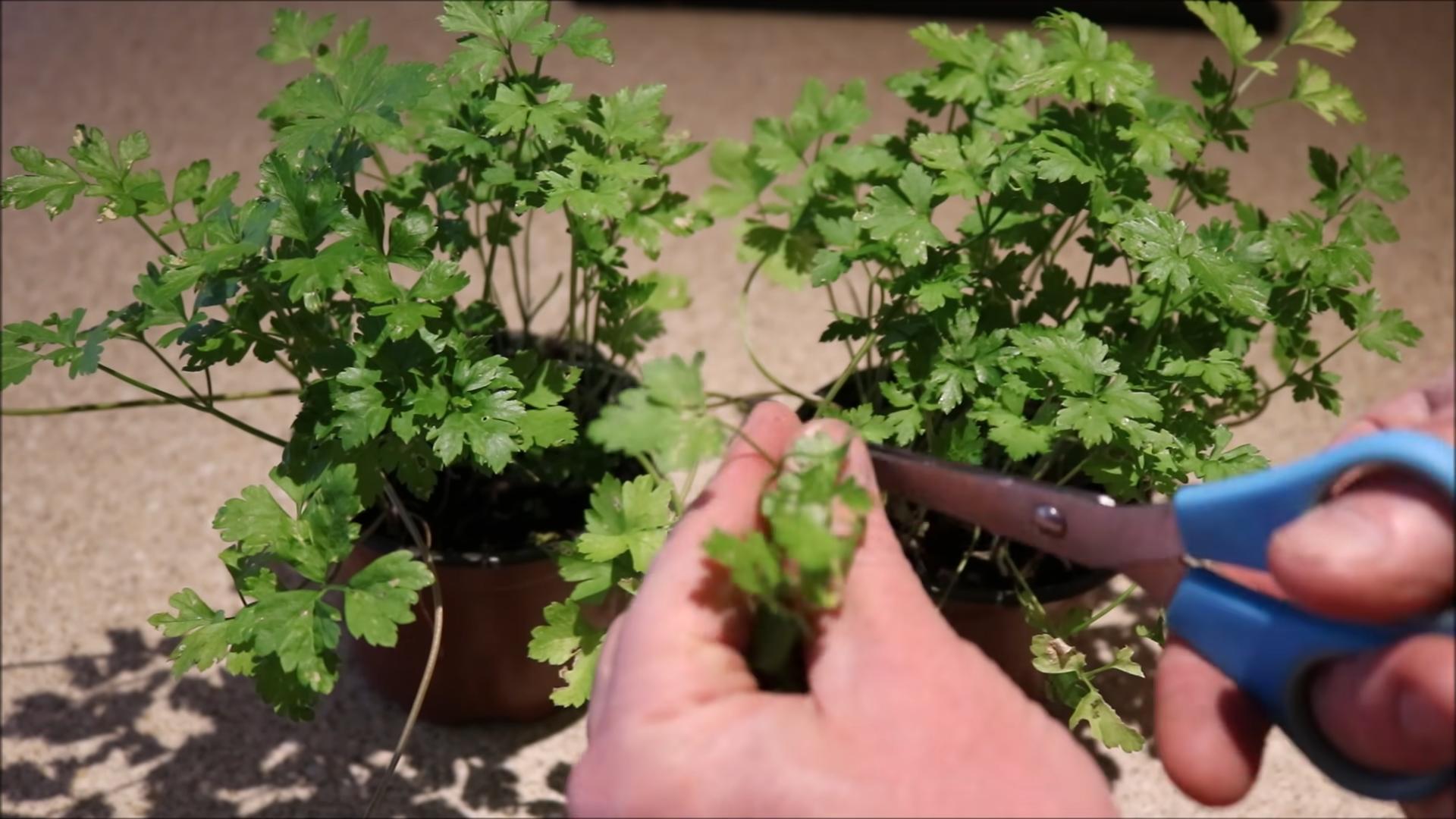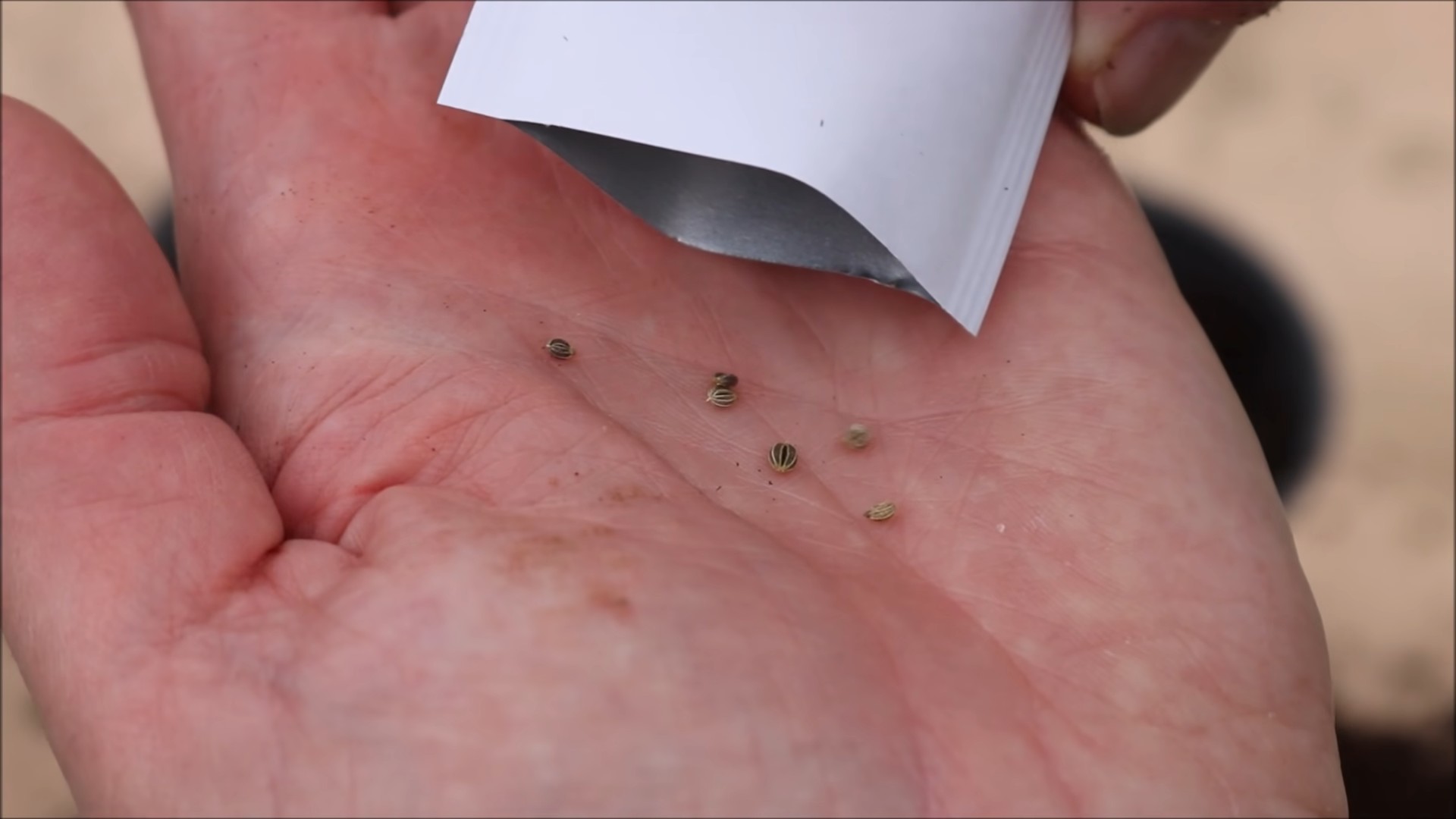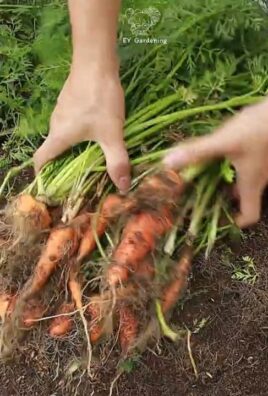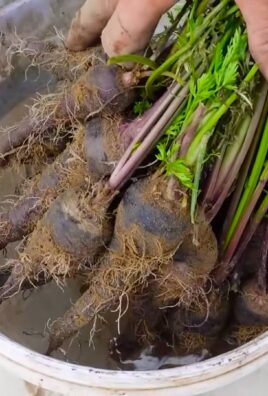Grow Parsley at Home and unlock a world of fresh, vibrant flavor right outside your door! Imagine stepping into your garden and snipping off a handful of fragrant parsley to elevate your next culinary masterpiece. No more wilted, overpriced bunches from the grocery store – just pure, homegrown goodness at your fingertips.
Parsley, with its bright green leaves, has been a culinary staple for centuries. Originating in the Mediterranean, it was once revered more for its medicinal properties than its flavor. The ancient Greeks even crowned victors with parsley wreaths! Today, it’s a beloved herb used globally to garnish dishes, add depth to sauces, and even freshen breath.
But why should you bother learning how to grow parsley at home? Well, for starters, it’s incredibly rewarding! Plus, store-bought parsley often lacks the intense flavor of freshly picked leaves. More importantly, growing your own allows you to control what goes into your food – no harmful pesticides or chemicals. In this article, I’ll share some simple, DIY tricks and hacks that will have you harvesting a bountiful parsley crop in no time, even if you have limited space or a less-than-green thumb. Get ready to transform your kitchen and your garden with this versatile and easy-to-grow herb!

Grow Your Own Parsley Paradise: A DIY Guide
Hey there, fellow garden enthusiasts! I’m so excited to share my tried-and-true method for growing lush, vibrant parsley right in your own home. Forget those sad, wilted bunches at the grocery store – fresh, homegrown parsley is just a few steps away, and trust me, it makes all the difference in your cooking! This guide will walk you through everything you need to know, from choosing the right seeds to harvesting your fragrant bounty. Let’s get started!
Choosing Your Parsley Variety
Before we dive into the nitty-gritty, let’s talk parsley types. There are two main varieties you’ll encounter:
* Curly Parsley: This is the classic, frilly parsley you often see as a garnish. It has a slightly milder flavor than its flat-leaf cousin.
* Flat-Leaf (Italian) Parsley: This variety boasts a bolder, more robust flavor that I personally prefer for cooking. It’s also a bit easier to chop.
Honestly, the choice is yours! I recommend trying both to see which one you like best. You can even grow both side-by-side for a diverse parsley patch.
Gathering Your Supplies
Okay, time to assemble our arsenal! Here’s what you’ll need to embark on your parsley-growing adventure:
* Parsley Seeds: Choose your preferred variety (curly or flat-leaf) from a reputable seed supplier.
* Potting Mix: Opt for a high-quality, well-draining potting mix. Avoid using garden soil, as it can compact and hinder drainage.
* Pots or Containers: Select pots that are at least 6 inches deep and wide. Good drainage is crucial, so make sure your pots have drainage holes.
* Watering Can or Spray Bottle: A gentle watering method is key to avoid disturbing the delicate seedlings.
* Sunny Location: Parsley thrives in a sunny spot that receives at least 6 hours of direct sunlight per day. A south-facing windowsill is ideal.
* Optional: Seed Starting Tray and Dome: These are helpful for starting seeds indoors, but not essential.
* Optional: Plant Food: A balanced liquid fertilizer can give your parsley a boost, but it’s not always necessary.
Planting Your Parsley Seeds
Now for the fun part – planting! Parsley seeds can be a bit slow to germinate, so patience is key. Don’t get discouraged if you don’t see sprouts right away.
1. Prepare Your Pots: Fill your pots with potting mix, leaving about an inch of space at the top. Gently pat down the soil to create a firm, even surface.
2. Sow the Seeds: Sprinkle the parsley seeds evenly over the surface of the soil. I usually aim for about 5-10 seeds per pot.
3. Cover the Seeds: Lightly cover the seeds with a thin layer of potting mix (about ¼ inch).
4. Water Gently: Use a watering can or spray bottle to gently moisten the soil. Avoid overwatering, as this can cause the seeds to rot.
5. Create a Humid Environment (Optional): If you’re using a seed starting tray and dome, place the pots inside and cover them with the dome. This will help to create a humid environment that promotes germination. If you don’t have a dome, you can cover the pots with plastic wrap, making sure to poke a few holes for ventilation.
6. Find a Sunny Spot: Place the pots in a warm, sunny location.
7. Be Patient: Parsley seeds can take anywhere from 2 to 4 weeks to germinate. Keep the soil consistently moist, but not soggy, during this time.
Caring for Your Parsley Plants
Once your parsley seedlings emerge, it’s time to provide them with the care they need to thrive.
1. Thin the Seedlings: Once the seedlings have developed a few sets of true leaves (the leaves that look like miniature versions of adult parsley leaves), thin them out, leaving only the strongest, healthiest plants in each pot. I usually aim for about 2-3 plants per pot.
2. Water Regularly: Water your parsley plants regularly, keeping the soil consistently moist but not soggy. Check the soil moisture by sticking your finger into the soil. If the top inch feels dry, it’s time to water.
3. Provide Plenty of Sunlight: Parsley needs at least 6 hours of direct sunlight per day to thrive. If you’re growing your parsley indoors, make sure to place it in a sunny windowsill. If you don’t have enough natural light, you can supplement with a grow light.
4. Fertilize (Optional): If you want to give your parsley plants a boost, you can fertilize them every few weeks with a balanced liquid fertilizer. Follow the instructions on the fertilizer label. I personally use a diluted fish emulsion fertilizer.
5. Pinch Off Flowers: Parsley is a biennial plant, which means it typically flowers in its second year. However, flowering can cause the leaves to become bitter. To prevent this, pinch off any flower stalks as soon as you see them.
6. Watch Out for Pests: Parsley is generally pest-resistant, but it can occasionally be affected by aphids or spider mites. If you notice any pests, you can try spraying them with insecticidal soap or neem oil.
Harvesting Your Parsley
The best part of growing your own parsley is, of course, harvesting it! You can start harvesting parsley leaves as soon as the plants are large enough to handle.
1. Harvest Regularly: Regular harvesting encourages the plants to produce more leaves.
2. Cut the Stems: Use scissors or pruning shears to cut the stems of the parsley leaves close to the base of the plant.
3. Don’t Take Too Much: Avoid harvesting more than one-third of the plant at a time, as this can weaken it.
4. Enjoy Your Fresh Parsley: Use your fresh parsley in your favorite recipes, or dry it for later use.
Drying Your Parsley
If you have more parsley than you can use fresh, you can easily dry it for later use. Here are a few methods:
* Air Drying: Tie the parsley stems together in small bunches and hang them upside down in a cool, dry, well-ventilated place. It will take several weeks for the parsley to dry completely.
* Oven Drying: Spread the parsley leaves in a single layer on a baking sheet and bake them in a preheated oven at 170°F (77°C) for 2-4 hours, or until they are completely dry.
* Dehydrator: If you have a food dehydrator, you can use it to dry your parsley. Follow the instructions on your dehydrator.
Once the parsley is completely dry, store it in an airtight container in a cool, dark place.
Troubleshooting
Even with the best care, you might encounter a few challenges along the way. Here are some common problems and how to address them:
* Slow Germination: Parsley seeds can be slow to germinate. Make sure the soil is consistently moist and the seeds are in a warm, sunny location. You can also try soaking the seeds in water for 24 hours before planting to help speed up germination.
* Yellowing Leaves: Yellowing leaves can be a sign of overwatering, underwatering, or nutrient deficiency. Check the soil moisture and adjust your watering accordingly. If the problem persists, try fertilizing your plants with a balanced liquid fertilizer.
* Leggy Plants: Leggy plants are often a sign of insufficient sunlight. Make sure your parsley plants are getting at least 6 hours of direct sunlight per day. If you don’t have enough natural light, you can supplement with a grow light.
* Pests: Parsley can occasionally be affected by aphids or spider mites. If you notice any pests, you can try spraying them with insecticidal soap or neem oil.
Extending Your Parsley Harvest
To enjoy fresh parsley for as long as possible, consider these tips:
* Succession Planting: Sow new seeds every few weeks to ensure a continuous supply of parsley.
* Overwintering: In mild climates, parsley can survive the winter. Protect the plants from frost by covering them with a layer of mulch.
* Bringing Plants Indoors: Before the first frost, you can dig up your parsley plants and bring them indoors to overwinter. Place them in a sunny location and water them regularly.
Parsley Propagation
Parsley is typically grown from seed, but you can also propagate it from cuttings, although it’s not as reliable.
1. Take Cuttings: In spring or summer, take 4-6 inch cuttings from healthy parsley stems.
2. Remove Lower Leaves: Remove the leaves from the bottom half of the cuttings.
3. Rooting Hormone (Optional):

Conclusion
So, there you have it! Growing parsley at home isn’t just a gardening project; it’s a gateway to fresher, more flavorful meals and a more sustainable lifestyle. We’ve walked you through the simple steps, from choosing the right seeds or seedlings to providing the optimal growing conditions. The beauty of this DIY trick lies in its accessibility. Whether you have a sprawling garden or just a sunny windowsill, you can cultivate your own supply of this versatile herb.
Why is this a must-try? Because the difference between store-bought parsley and freshly grown parsley is astounding. The aroma is more vibrant, the flavor is more intense, and the satisfaction of harvesting something you nurtured yourself is unparalleled. Plus, you’ll be saving money and reducing your reliance on pre-packaged herbs that often lose their freshness before you even get them home.
But don’t stop there! Experiment with different varieties of parsley. Curly parsley is a classic choice, known for its decorative appeal and slightly milder flavor. Flat-leaf (Italian) parsley boasts a more robust, peppery taste that’s perfect for sauces, soups, and salads. Consider companion planting your parsley with tomatoes, carrots, or roses – they all benefit from each other’s presence. You can also try growing parsley indoors during the colder months to enjoy a year-round supply. If you find yourself with an abundance of parsley, don’t let it go to waste! Chop it up and freeze it in ice cube trays with a little water or olive oil for easy access to fresh parsley whenever you need it. Alternatively, dry your parsley by hanging bunches upside down in a cool, dark, and well-ventilated area. Once dried, crumble it and store it in an airtight container.
We truly believe that once you experience the joy of harvesting your own fresh parsley, you’ll never go back to buying it from the store. It’s a simple, rewarding, and delicious way to connect with nature and elevate your cooking.
So, what are you waiting for? Grab some seeds or seedlings, find a sunny spot, and embark on your parsley-growing adventure today! We’re confident that you’ll be amazed by the results. And most importantly, we want to hear about your experience! Share your tips, tricks, and photos with us in the comments below. Let’s build a community of home gardeners and inspire others to discover the magic of growing their own fresh herbs. Tell us about the challenges you faced, the successes you celebrated, and the delicious dishes you created with your homegrown parsley. Your insights could be invaluable to other aspiring gardeners. Let’s get growing!
Frequently Asked Questions (FAQ)
1. What is the best time of year to plant parsley?
Parsley is a biennial plant, meaning it has a two-year life cycle. However, it’s typically grown as an annual for its leaves. The best time to plant parsley depends on your climate. In areas with mild winters, you can plant parsley in early spring or fall. In colder climates, it’s best to start seeds indoors 6-8 weeks before the last expected frost and transplant them outdoors after the danger of frost has passed. You can also directly sow seeds outdoors in the spring once the soil has warmed up. For a continuous harvest, consider succession planting, sowing new seeds every few weeks.
2. How much sunlight does parsley need?
Parsley thrives in full sun, which means it needs at least 6-8 hours of direct sunlight per day. However, in hotter climates, it can benefit from some afternoon shade to prevent the leaves from scorching. If you’re growing parsley indoors, place it near a sunny window or use a grow light to provide adequate light. Insufficient sunlight can result in leggy growth and reduced flavor.
3. What kind of soil is best for growing parsley?
Parsley prefers well-draining soil that is rich in organic matter. The ideal soil pH is between 6.0 and 7.0. Before planting, amend the soil with compost or well-rotted manure to improve its fertility and drainage. If you’re growing parsley in containers, use a high-quality potting mix that is specifically formulated for herbs or vegetables. Avoid using heavy clay soil, as it can become waterlogged and lead to root rot.
4. How often should I water parsley?
Parsley needs consistent moisture to thrive, but it doesn’t like to be waterlogged. Water deeply whenever the top inch of soil feels dry to the touch. Avoid overhead watering, as it can promote fungal diseases. Instead, water at the base of the plant. During hot, dry weather, you may need to water more frequently. Mulching around the plants can help to retain moisture in the soil.
5. How do I harvest parsley?
You can start harvesting parsley leaves once the plants are about 6 inches tall. To harvest, simply snip off the outer leaves near the base of the plant, leaving the inner leaves to continue growing. Avoid removing more than one-third of the plant at a time, as this can stress the plant and reduce its productivity. Regular harvesting encourages new growth and prevents the plant from bolting (going to seed).
6. Why is my parsley turning yellow?
Yellowing parsley leaves can be caused by several factors, including overwatering, underwatering, nutrient deficiencies, and pests or diseases. Check the soil moisture to ensure that you’re not overwatering or underwatering. If the soil is consistently wet, improve drainage. If the soil is dry, water more frequently. Yellowing leaves can also indicate a nutrient deficiency, such as nitrogen or magnesium. Amend the soil with compost or use a balanced fertilizer to provide the necessary nutrients. Inspect the plants for pests, such as aphids or spider mites, and treat them accordingly. Fungal diseases can also cause yellowing leaves. Remove any affected leaves and treat the plants with a fungicide if necessary.
7. How do I prevent parsley from bolting?
Bolting is when a plant prematurely flowers and goes to seed. Parsley is more likely to bolt in hot weather or when it’s stressed. To prevent bolting, provide parsley with some afternoon shade in hot climates. Water regularly to keep the soil consistently moist. Harvest the leaves frequently to encourage new growth and prevent the plant from focusing on seed production. If your parsley does bolt, you can still harvest the leaves, but they may have a slightly bitter taste.
8. Can I grow parsley indoors?
Yes, you can grow parsley indoors, but it requires adequate light and proper care. Choose a sunny window that receives at least 6-8 hours of direct sunlight per day. If you don’t have a sunny window, use a grow light to provide supplemental light. Use a high-quality potting mix and water regularly, allowing the soil to dry slightly between waterings. Fertilize every few weeks with a balanced fertilizer. Rotate the plant regularly to ensure even growth.
9. What are some common pests and diseases that affect parsley?
Parsley can be susceptible to several pests and diseases, including aphids, spider mites, carrot rust flies, leaf spot, and powdery mildew. Inspect the plants regularly for signs of pests or diseases. Treat aphids and spider mites with insecticidal soap or neem oil. Protect parsley from carrot rust flies by covering the plants with row covers. Prevent leaf spot and powdery mildew by providing good air circulation and avoiding overhead watering. Remove any affected leaves and treat the plants with a fungicide if necessary.
10. How can I store fresh parsley?
To store fresh parsley, trim the stems and place the bunch in a glass of water, like you would with cut flowers. Cover the leaves loosely with a plastic bag and store in the refrigerator. Change the water every few days. This method will keep parsley fresh for up to a week. You can also wrap parsley in a damp paper towel and store it in a plastic bag in the refrigerator. For longer storage, chop the parsley and freeze it in ice cube trays with water or olive oil.





Leave a Comment